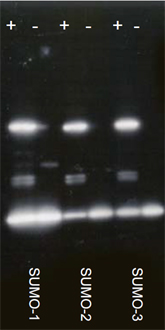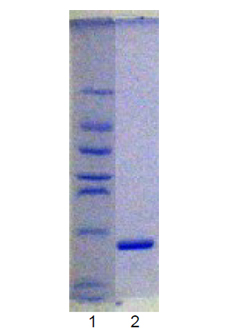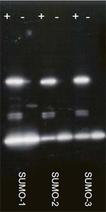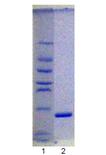Replaces Prod. #: ALX-201-046
SUMO-conjugating enzyme.
Product Details
| Sequence: | Accession number: P63279; Length: 158 amino acid residues. |
| |
| MW: | ~18kDa |
| |
| Source: | Produced in E. coli as an untagged protein. |
| |
| UniProt ID: | P63279 |
| |
| Formulation: | Liquid. In 20mM HEPES, pH 7.3, containing 110mM potassium acetate, 2mM magnesium acetate, 0.8mM EGTA, and 1mM DTT. |
| |
| Purity: | ≥95% (SDS-PAGE) |
| |
| Purity Detail: | Purified by ion-exchange chromatography. |
| |
| Application Notes: | Uses:
1. SUMO modification of specific proteins in vitro.
2. Demonstrate novel proteins are potential targets for SUMOylation under in vitro conditions.
3. Generate substrates for deSUMOylating enzymes.
4. Investigation of direct Ubc9-substrate interactions. |
| |
| Shipping: | Dry Ice |
| |
| Long Term Storage: | -80°C |
| |
| Scientific Background: | The mechanism for SUMO conjugation is analogous to that of the ubiquitin system. Unlike ubiquitinylation, which leads inter alia to a degradative pathway, SUMO modification of target proteins is involved in nuclear protein targeting, formation of sub-nuclear complexes, regulation of transcriptional activities, and control of protein stability. A short sequence containing the consensus Ψ-K-X-D/E (where lysine is the modified amino acid, Ψ is a large hydrophobic residue and X is any amino acid residue) is thought to be necessary for protein SUMOylation to occur however SUMOylation has also been observed in cases where the consensus site is not conserved. Ubc9, the only SUMO E2 enzyme, conjugates activated SUMO (but not ubiquitin) and mediates its subsequent linkage, via C-terminal isopeptide bond formation, to a number of proteins, including RanGAP1, SP100, p53, IκBα and PML, without the absolute requirement for an E3 ubiquitin-protein ligase-like activity, at least in vitro. Direct interaction of UbcH9 with protein substrates, an unusual feature for an E2 conjugating enzyme, is thought to play a role in substrate recognition.The SUMO E1 activating enzyme heterodimer (Aos1/Uba2) is also required for initiation of the SUMOylation cascade. |
| |
| Regulatory Status: | RUO - Research Use Only |
| |

SUMOylation assays for RANGAP1 target protein using SUMO-1, 2 and 3. SUMOylated proteins were detected by Western blotting using the appropriate BIOMOL SUMO antibodies. Results demonstrate the formation of SUMOylated target proteins of the expected size in all ATP containing reactions (+). The absence of such conjugates in negative control reactions (–) demonstrates that their formation is ATP dependent (required for E1 activation) and hence derived from the SUMO cascade.

Coomassie stained gel of BML-UW9320. Lane 1: MW markers (top to bottom) 66, 45, 36, 29, 24, 20, 14 and 6. Lane 2: BML-UW9320 (2μg).
Please mouse over
Product Literature References
DEK oncoprotein participates in heterochromatin replication via SUMO-dependent nuclear bodies: A. Pierzynska-Mach, et al.; J. Cell Sci. (2023),
Abstract;
Tricyclic antidepressants target FKBP51 SUMOylation to restore glucocorticoid receptor activity: M.L. Budziñski, et al.; Mol. Psychiatry
27, 2533 (2022),
Abstract;
An electrophoretic mobility shift assay identifies a mechanistically unique inhibitor of protein sumoylation: Y.S. Kim, et al.; Chem. Biol.
20, 604 (2013),
Abstract;
Full Text















